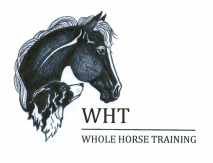Posture Mirrors: Horse and Rider Reflect One Another
|
1. The child is following the directive to "sit up straight," but it's causing him to arch his back and grip with his thighs, as he's pitched forward onto his pubic bone.
2. Posture lines match. He is out of balance, and his horse is plodding along in the same posture. 3. Compression and restricted movement results. He is reaching for his stirrups, an action that eliminates movement in the hinges of his ankles, knees, and hips. This light, little rider is driving this horse’s forehand into the ground. 4. Her body is out of balance and she is arching.. She is gripping with her knees, jamming her heels down and bracing in her stirrups. She is rigid and her joints are not moving. |
|
|
5. Posture lines match. Her horse is likewise incapable of offering the kind of free and easy movement that comes from traveling in neutral posture.
6. Carrying a rider that is braced and static forces a horse into compensatory patterns of movement. The areas of compression are clearly marked. His hind legs are not lifting; they are pushing out behind. He is braced in his body and he is base down. 7. Everything about the way this horse is going is directed down, toward the ground. His hind legs are pushing him forward and his front legs are catching his weight and the weight of his rider to keep him from collapsing onto his chest when the next forward thrust comes. 8. These lines show that the posture of the rider, which is a slumped, out of balance C-curve is mimicked by the horse. The big red arc does not indicate that the horse’s back is lifting. |
Watch this slide show and see the effects common riding postures have on horses.
9. Compression and restricted movement results. Traveling in this bad posture is not okay for this horse in terms of function, soundness or longevity. If a rider fails to take responsibility for his or her own body function, a vicious cycle of dysfunction results. Often riders focus exclusively on how they influence the posture and way of going of their horses. In Connected Riding® we understand that a horse’s way of going also affects a rider, especially one who is not fully conscious of the give and take exchange that occurs between partners when horseback riding. Riders often focus intensely on the fact that their mount is one-sided without considering that they may well be one-sided as well. As a bodyworker, I am constantly reminded of the affects a rider has on her horses when I see the same patterns of stress in all of the horses that one particular person rides or trains. |
